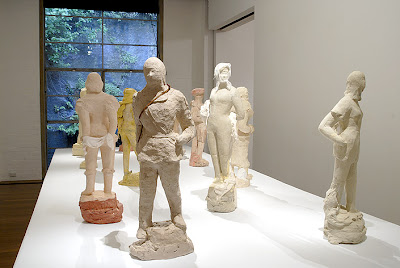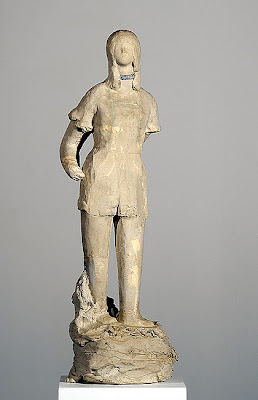From Bonny Dot Cassidy
They come loitering down a runway, into Linda Marrinon’s sixth solo show Figure Sculpture II at Roslyn Oxley9 [until March 1]. Beautiful troopers that they are, it’s hard not to wish for a battalion rather than the mere eleven figures that carry on from the sculptor’s last figure collection. But perhaps there’s something about the exclusivity of the bevy that adds to its sense of preciousness, a gem-like quality that makes these little (mostly) women seem as if they’ve been dug up from the earth after years of rest.

Linda Marrinon, Beautiful Troopers, installation view.
Courtesy Roslyn Oxley Gallery.
Marrinon has used tinted plaster, giving lumpy bases the effect of eroded clay. While the figures appear to be standing on rocky outcrops or blasted tundra, their upright bodies are smooth and sleek in the way of dogs; rustic and textured but with that tight, flat composure that begs a hand on the haunch. I was afraid—not of the figures but the CCTV—to touch, but I bet they feel as good as they look. Woman in high-waisted pants is crowned with a Lawrence of Arabia turban, blazing ochre yellow, that she pulls aside from her cheek with a truncated, oversized hand. The frozen fabric around her neck and shoulders billows into rough, sinewy clouds. It’s as if her face is peering out of a Caspar Friedrich sunrise. I wore some such thing when approaching mosques in Turkey, but emerged like a chipmunk from a holey sock. As for those titular slacks—they have the same golden hue as the fabric, but here the tint covers an undercoat of sky blue. The sun really is shining out of her pants.
Attracted by Marrinon’s deft arrangement of fabric, rivulets of sharp shadow are one of the most outstanding effects of this series. The lighting of the figures is sensitive and reverent, blinding from directly overhead so that their curious Hergé faces peer out from all manner of headdress. There’s the Outdoors woman dressed in pelts, whose cylindrical hat balances her stocky, bear-like limbs and capable Inuit boots. And the Knight in chain mail, who I mistook for Jeanne D’Arc, with a simple helmet edge incised around his face and barely any colouring. Again, Marrinon achieves the impact of terracotta soldiers with these ascetic lines and surfaces. The only indulgence of excess appears in their uniformly protuberant behinds, which are somewhat shocking to discover as you round the table. Sort of like finding that the Crucifixion on the wall has been given a bum as lifelike as his cranial agony.
And thus the other obvious point of reference for Marrinon is medieval Christian iconography. The works reminded me of one spare timber St Michael perched in the abbey atop Mont Saint-Michel in western France. For all the talk about mannequins and fashion surrounding this show, I find Marrinon’s postures more saintly than self-aware; even down to incongruous details like spat buttons on an invisible trouser. There are humour and warmth here, but I think her sculptures are on more important missions than glamour. Take, for instance, the utilitarian and ethnic nature of all the costumes, which seem to be prepared for stolid journeys into far-off lands. Indeed, Daisy Bates came to mind more than once—especially considering those outrageous hats. Marrinon captures, too, the heroic air of painterly legends: Goya’s Maya (that’s our high-waisted lady), and the women and goddesses of Ingres, Velasquez and Botticelli. This fabricated archaism, this Classical chic, this angel at my table has all sold out.

